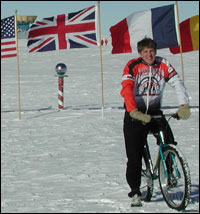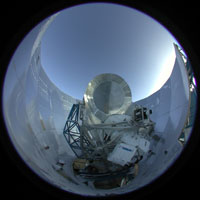|
|
 |
Astrophysicist Jeff Peterson's Paper is one of the Most Cited in Space Science

Jeffrey Peterson, shown here at the South Pole. |
A research article by Jeff Peterson, professor of Physics, was recently noted by ISI® as one of the most highly cited papers in space science. The paper, "High-resolution Observations of the Cosmic Microwave Background Power Spectrum with ACBAR," was published in Astrophysics Journal/600 in January 2004.
Peterson's article presents the most descriptive, sensitive images to date of cosmic microwave background (CMB) radiation, which carries information to us from the earliest moments of the Big Bang.
"By studying the structure in CMB images, scientists can sort out the various components of the universe today," Peterson said.

Viper, the largest telescope at the South Pole, was built by Carnegie Mellon students under Peterson's direction. |
Features found in Peterson's images are about four times smaller than those seen using the space-based Wilkinson Map Anisotropy Probe. That's because the images reflect measurements of CMB over a small portion of the sky. These images were taken with the Arcminute Cosmology Bolometer Array Receiver (ACBAR), using the Viper Telescope. Viper, the largest telescope at the South Pole, was built by Carnegie Mellon students under Peterson's direction.
Most recently, Peterson has been assembling the PrimevAL Structure Telescope (PAST) in Xin-Jiang, China. Ultimately, PAST will map the earliest structures of the universe. For more on the PAST, see http://www.post-gazette.com/pg/04362/432803.stm
For more on Peterson's paper, visit http://www.esi-topics.com/fbp/2004/december04-JeffPeterson.html
Lauren Ward
|

